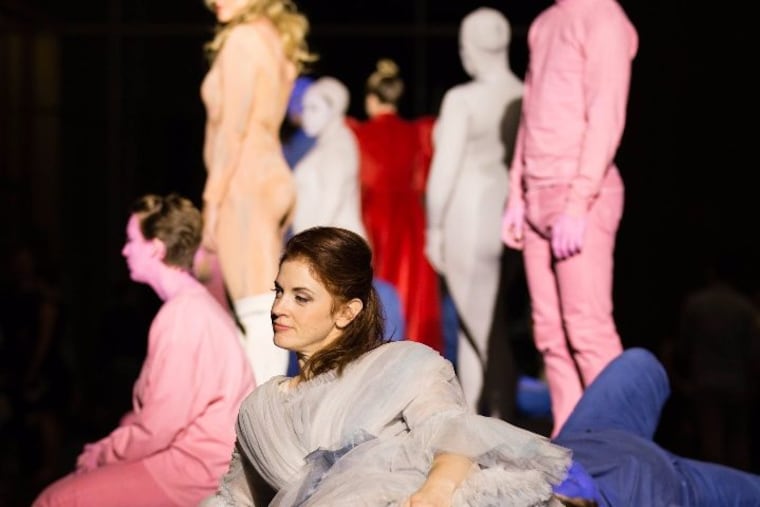O17 hits the Barnes with a hallucinatory fairy tale
With "pink people" and a score by Curtis-trained composer David Hertzberg, "The Wake World" is an aesthete's feast.

The pink people, a lovely shade from head to toe, started to appear in the galleries of the Barnes Foundation just after 7:30. A man with a Jimmy Durante rubber nose shuffled by an ensemble of paintings by Horace Pippin and William Glackens. That's how you knew the opera was about to start.
Arts groups are forever talking about getting away from tired formats and immersing audiences in the art. Opera Philadelphia on Monday night did something about it. At the start of The Wake World, receiving its premiere as part of the company's O17 festival, you couldn't be sure who was performer and who was audience.
A long catwalk ran down the middle of the Annenberg Court. Performers sang upon it or fanned out among the listeners. The audience was encouraged to walk about, sometimes physically trailing the singers as they went about the action. There was something exhilarating about all of this in an art form usually laced up tight in strict roles and decorum.
Such liberation might not have worked well in other repertoire. But The Wake World, by David Hertzberg, is music to draw up around you like velvet — or, to borrow from Hertzberg's own libretto, "such soft violet glistens like this place." The prose was purple, and so was the music, so thoroughly an antique musical language that it sounded like a half-remembered dream Szymanowski once had about Scriabin. A lesson in music theory isn't necessary here, but suffice it to say that Hertzberg, with degrees from both Juilliard and Curtis, recognizes the mystical qualities of a harmonic world that constantly resists resolution. It floats.
And so does the opera. Based on a fairy tale by Aleister Crowley, the colorful early 20th-century British poet and magician, the opera's story follows some of the same themes as Bluebeard's Castle, in the symbolist mode of Maeterlinck. It is the tale of a seeker who encounters a prince and ends up being consumed in love by way of some ecstatic transformation of consciousness. It may be no surprise that Crowley's drug of choice was hashish.
The piece purportedly has something to do with Dr. Albert Barnes, whose impressionist, post-impressionist, and early modern paintings (not to mention a stray Bosch, a soup ladle, and other metal objects) hang in the adjacent galleries. The opera company had promised much: "Works of art jump off the gallery walls and into the action as the museum is transformed," a marketing blurb said. Not quite. Some of the characters looked like they had perhaps walked out of a painting, and there was a fairy prince in a suit with a pipe — Dr. Barnes, perhaps? No matter. You don't ask for accuracy at an aesthete's feast, and this surely was one.
The chorus and small ensemble, both in wonderful form led by Elizabeth Braden, made for an enveloping pleasure. "Breathe the omnipresence of my body," the chorus sang, and we did. Sometimes a singer walked behind you, and as that sound blended with the orchestra and singers elsewhere, you had the oddly powerful sensation of what it might be like to live within the body of an instrument.
For the performers, there was nowhere to hide — the direction was by R.B. Schlather — which seemed only to heighten the sense of daring and trust between singers and listeners. When the soprano loses it and you're sitting close enough to feel her breath, the singing had better be good, and very good it was. Lola the seeker, sung by soprano Maeve Höglund (in a dress inspired by a Renoir painting in the collection), was astonishingly assured. Rihab Chaieb was the prince, slipping on a throaty and agile mezzo.
It takes a good deal of bravery, too, to write a score as specifically retro as this one. But Hertzberg makes a convincing case that this offshoot of expressionist music has more to give.
There was an irony at play here probably not lost on anyone who lived through the legal battle civic leaders waged to extract the Barnes collection from its longtime home in Lower Merion. In its original environment, you had to confront the art on its own terms, in an inconvenient place, in a setting controlled from beyond the grave of its founder. It was once, let's not forget, a fully immersive experience.
The Wake World
Continues at the Barnes Foundation Sept. 19, 23, 24 and 25.
Tickets: $50-$100, limited seating for Tuesday show only; others sold out.
Information: 215-732-8400 or www.philaopera.org.